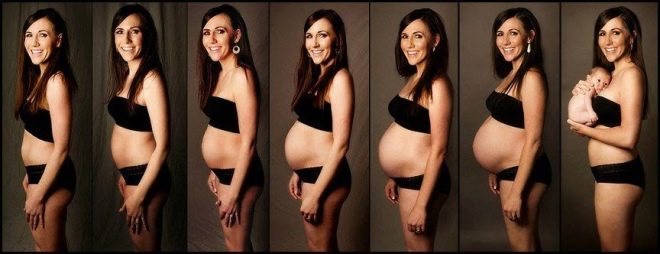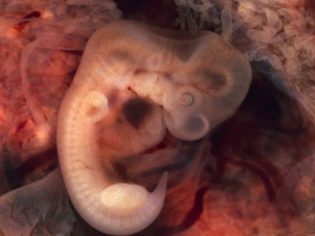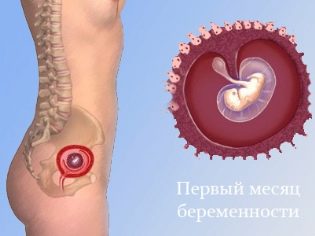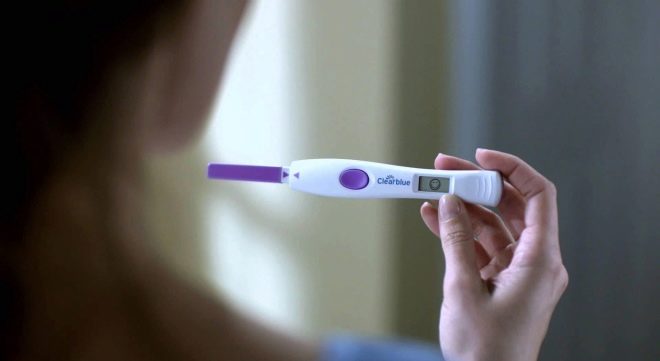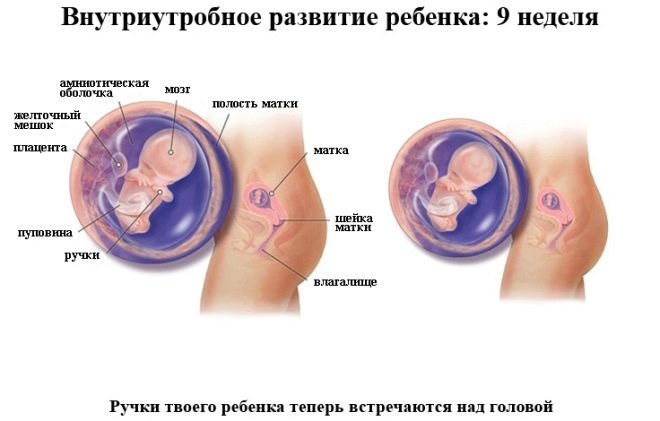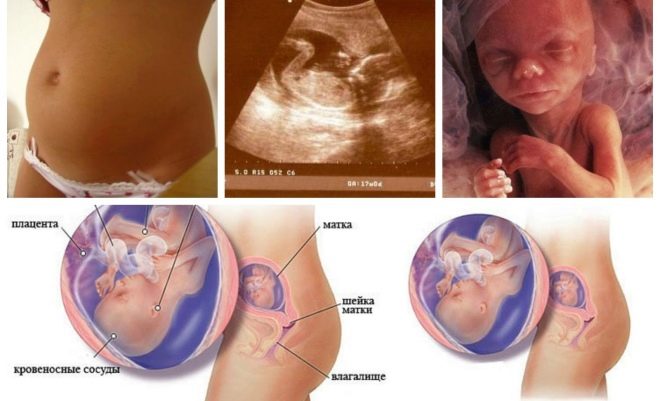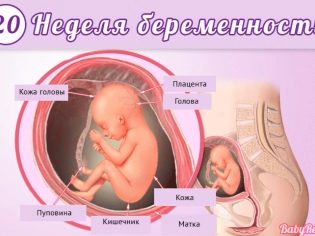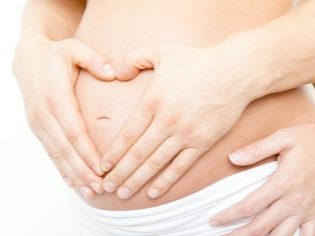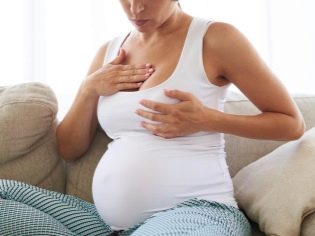Monthly Pregnancy
The months of pregnancy are amazing, one is not like the other, and with each month there are many changes with the baby and mother. We are accustomed to assume that there are 9 months in pregnancy, and obstetricians number 10, and there is nothing unusual in this: every obstetric month has exactly four weeks or 28 days, whereas in calendar months it is from 28 to 31 days.
If you look at the pregnancy by month, then the invisible changes that await your mother and baby on the way to a significant event - the birth of a child will become more obvious.
The first
The first month of pregnancy begins when no pregnancy is still in sight - on the first day of menstruation, opening a new cycle, which will be special for women. It includes 4.5 calendar weeks from 1 to 4.5. Most women do not even realize that they are in the first month, because it ends when the woman has only 2-3 days of delay.
Around the middle of the first month, a new life is born - conception takes place. Within a few days, the baby, which is represented by constantly dividing cells, moves into the uterus, where it has to consolidate and begin to develop. It depends on how successful the implantation is whether the embryo will develop further and whether the pregnancy will continue. Having attached to the wall of the uterus a week after conception, the baby begins to receive food and oxygen from the maternal blood - chorionic villi produce it.
At the end of the first month the size of the embryo does not exceed 1 millimeter. Amnion is formed, which begins to produce the very aquatic environment in which the baby will stay until the birth. A heart is being formed, but it is not yet beating. The laying of the neural tube begins, the fetal sex cells are formed. What he will be sex, it is known from the moment of conception.
The signs and symptoms of a pregnancy take place prematurely, they are too subjective. Only with the beginning of the delay, at the very end of the first month of pregnancy, you can do tests and conduct blood tests for hCG.
Depending on how high the individual sensitivity of a particular woman is, some people feel a period of implantation, they observe implantation bleeding, but this is not typical of everyone. Some may notice the first signs of pregnancy even before the delay, and they are usually associated with the action of progesterone, which is produced in large quantities - there is a slight bloating, the temperature rises towards evening, urination may slightly increase.
Second
It is this month that starts at 4.5 weeks and ends at 8 weeks, the delay of periods begins and the state of health of the future mother changes. The period of active organogenesis of the fetus is very responsible and important, as well as the most critical. All internal organs are formed, and changes do not even occur every day, but every second.
At 5 weeks, a tiny baby heart begins to beat. At week 6, an fetal egg and the heartbeat of the child are determined by ultrasound. At this time the fetal immune system is laid, the formation of facial structures begins. At week 7, the embryo is clearly defined inside the ovum.At week 8, the development of the nervous system begins, the separation of the brain and spinal cord occurs. By the end second month baby's height reaches 2.5 centimeters.
Women during this period often have toxicosis, and this month, most expectant mothers are registered in consultation. The chest begins to hurt, in colds, colostrum can be slightly excreted.
Third
The third month includes period from 9 to 13 week and it completes the first trimester. It is considered one of the most difficult for a woman if she suffers from toxicosis, since during this period the process of placentation is actively underway. But it is not long to wait for relief - by the 13th week of the gestational period the placenta will start to work fully and the woman will feel better.
By the end of the month begins to grow belly. From 9-10 weeks, when the formation of the internal organs of the baby is completed, they begin to call him not the embryo, but the fetus. At week 9, the baby begins to move his arms, open his mouth. The embryo looks even more than strange, but it is already starting to get rid of the embryonic tail, legs are forming.
At 9 weeks, the beginnings of milk teeth are laid, the pituitary gland is formed, neurons begin to form. At week 10, the right and left hemispheres of the brain are separated, the baby begins to swallow the amniotic fluid. Formed face, ears.
Soft cartilaginous bones begin to harden gradually, mineralization is taking place, the need for calcium is high.
At week 11, the structures of children's eyes and the optic nerve are formed, and from week 12, the nasal bone grows, fingers form. The formation of the external genital organs. By the end of the third month, the child begins to demonstrate the first mimic skills - frowning and smiling. By the end of the month, the child reaches a height of 10-12 centimeters and his weight is already approaching 30 grams.
At the end of the third month from 11 to 13 weeks, the first prenatal screening is held to identify the increased risks of having a baby with chromosomal abnormalities.
Up to 12 weeks it is important to be sure to register. This is considered an early production, a woman will be paid a lump-sum benefit from the state for her.
Fourth
Period from 14 to 17 week - the beginning of the second trimester of pregnancy. This month is considered one of the lightest (the fetus is still small, and toxicosis is already passing). From this month, a woman can afford what was unacceptable in the first trimester - the list of medicines that can be used in case of illness is expanding. if necessary with precautions To dye hair, to treat teeth, If you want to.
But you can not sleep on your stomach and back, you should more carefully choose the posture for sex to sleep with her husband safely.
The development of the fetus in the womb is somewhat slowed down, and now all the organs that have been formed are simply growing. Baby starts to gain weight. The main risks and dangers are left behind.
- On week 14 hair begins to grow on the children's head, all fruits are still discolored, there is no coloring pigment. The child has its own fingerprints, the optic nerve ripens, thanks to which the fetus learns to distinguish between light and darkness.
- On week 15 the first gyrus appears in the brain. Physical activity of the baby increases, his liver begins to work, his lungs perform training respiratory movements, and the intestine begins to weakly contract, “rehearsing” motility.
- From week 16 kids have dreams and muscle formation is completed. At 16 weeks the child has a hearing, he perceives high-frequency loud sounds, he has his own blood type and Rh factor. On the ultrasound with great accuracy, you can determine the sex of the baby.
- On week 17 the fetus for the first time acquires a resemblance to relatives, acquires individual traits.
Fifth
The fifth month usually does not cause a woman trouble. Unpleasant sensations in this period - the minimum, and the pleasure of his position - the maximum. This period includes 18-21 weeks.. Reduced risk of miscarriage and fading of pregnancy. In the movements of the future mother, a special smoothness appears, the belly grows up, but while it is still small.
The first stretch marks may appear, and therefore it is important to monitor normal weight gain and care for the skin of the abdomen, thighs and mammary glands.
The baby begins to acquire normal proportions - now its head is not equal to half the area of the whole body, it grows more slowly than its legs, arms, and body. All internal organs work. From the 19th to the 20th week, the subcutaneous adipose tissue begins to accumulate, due to this, the baby will now “grow heavy” faster than increasing growth. From this period, you can expect the first movements. The child is pushed intensively, but it is small, and therefore the first movements of the fetus in the womb are felt as light touches.
A full hearing is formed at 20 weeks.. The skin becomes four-layered, the process of falling lanugo begins - thin hair that covers the entire skin to protect it. A blinking reflex is formed.
From 20-21 weeks the fetus’s own immunity begins to work. Hemispheres are also differentiated - the child is either right-handed or left-handed.
By the end of the fifth month, the child comes up with a weight of 400-450 grams and is almost 26-28 centimeters tall.. Almost all the reflexes necessary for survival appear.
From 16 to 21 weeks, a second prenatal screening is held to identify possible chromosomal abnormalities of the fetus, as well as neural tube defects.
Sixth
This month is the last month of the second trimester. It includes the period from 22 to 26 weeks of pregnancy plus a few days from 27 weeks. That is why the information about the end of the second trimester is so different: some say that the trimester is completed at 26 weeks, and others - at 27 weeks. If accurate, it ends at 26.5 weeks.
From the 22nd week, the babies for the most part reach a weight of 500 grams, and now, if the birth begins, they will be just premature birth, not miscarriage. Crumbs doctors are now obliged to save at any cost. The crumb is still thin, it does not have enough fatty tissue and immature lungs, and therefore it is necessary to try to avoid childbirth. At week 23, the child’s sweat and sebaceous glands begin to function, and personal preferences appear - there are sounds that he no longer likes. At the 24th week, the fetus temperament is quite clearly defined - according to his movements, behavior. Many women are already establishing full contact with their babies.. Maturation of the fetal lung tissue begins this week - a phospholipid surfactant substance is formed in the alveoli.
At week 25, reflexes of the fetus are refined. The pigment begins to be produced, which dyes the baby's hair in the color that is predetermined for him by the genetic program laid down at conception.
At 26 weeks, the baby usually turns upside down and is fixed in this position until the birth. Previously, he could spin and roll as he pleases, now there is not enough space in the uterus. Nine out of ten fruits are now in the main presentation. The gonads of boys (testicles) begin to descend into the scrotum. In the end sixth month the baby is getting stronger. In the case of childbirth at 22 weeks, the probability of survival does not exceed 7-15%, and already at 26 weeks the chances are estimated at 35-40%.
The stomach grows actively, it is already impossible to hide it. The breast becomes more lush, large, the amount of vaginal discharge increases. During this period, some begin to experience training bouts (short-term and non-constant uterine muscular tension).
Seventh
The last trimester begins, which will require patience and endurance from the woman. AT seventh month 27, 28, 29, 30 weeks are included. The last weeks before the decree are not easy. A woman can start insomnia, heartburn, some already have shortness of breath, because the uterus takes up to 70% of the abdominal cavity.
The baby in the womb continues to increase its weight and grow. Lung tissue is actively ripening - this process does not stop for a minute. At week 27, the baby becomes crowded in the uterus, he assumes a flexion pose, in which the legs are pressed to the stomach, and the chin to the chest. From this point on again, as in the early stages, it becomes difficult to determine the sex of the child on an ultrasound scan - now the genitals are hardly distinguishable because of the umbilical cord passing between the legs.
The baby has improved vision. At week 28, lashes grow significantly and the cheeks are rounded. The survival rate of the fruits born on this period is close to the record 90 percent for the very premature. The process of differentiation of the cerebral cortex is fully completed.
At 30 weeks, women are on maternity leave if they are pregnant with one baby. With twin, long-awaited maternity leave is available from 28 weeks.
By the end of the month, children on average reach weights of 1600-1800 grams with growth of 42 centimeters. The skin folds are gradually smoothed, the baby ceases to be bright red, most of the lanugo hair falls out.
Now a woman should pay special attention to her weight and swelling. Puffiness, abnormal increase, and high blood pressure are signs of a dangerous third trimester complication — preeclampsia.
A large abdomen changes the distribution of the load on the spine, women have a specific "duck" gait. Having sex is possible if there are no contraindications from the gynecologist, as well as flying on an airplane. But in any case, on the trip you need to ask permission of the attending doctor.
Eighth
In the body of a woman begins the process of prenatal preparation. There is a feeling of fatigue. Carrying a baby is becoming more difficult. The month starts at the end of the 30th week and ends at 34th week plus a few days.
The baby is still reliably protected by the placenta, its aging processes have not yet started. He is actively gaining weight, every day becoming more and more like a newborn. Births at this time are no longer as dangerous as before, but due to insufficient maturity of the lung tissue, the risks of distress syndrome still exist.
At week 31 is the process of maturation of the kidneys, lungs. The skin acquires the color envisioned by the genome — dark-skinned babies become just that, and representatives of the European race keep their skin pink.
From week 32, fetal motor activity decreases, because there is almost no room left for movements in the uterus. The gradual process of reducing the amount of amniotic fluid begins.. In the body of the future mother begins to produce oxytocin in small portions, which will help in time the onset of labor contractions.
33-34 weeks past the last prenatal screening. A week baby adds 300 grams, and this is a record increase for the entire period of intrauterine development. In the end eighth month begins the process of aging the placenta. By the end of the month, the baby comes with an average weight of 2.3-2.9 kilograms with a height of 47 centimeters.
The mobility of the future mother noticeably decreases, anxiety and emotional instability appear. The uterus props up the diaphragm, the ribs may begin to hurt. The body produces relaxin, which softens the bones and ligaments, which leads to pain in the pubis and the coccyx. Many complain of insomnia.
Ninth
A woman and her child are entering the home stretch. This is the final month of pregnancy and the third trimester. Childbirth can happen at any time. The ninth month is considered to be from 35.5 weeks to delivery.. From 37 weeks, childbirth ceases to be premature, and the baby is premature.
Preparing for childbirth is not only a woman, but also her crumb. He "hones" adaptation skills, because he will soon have to radically change the habitat. At 35 weeks, abdominal prolapse usually occurs in primiparous, later - in those who give birth again. The babies now occupy a place in the lower part of the uterus and with their head they put pressure on the inner throat of the cervix, thus bringing its maturation and opening closer.
The bones of the baby’s skeleton are strong and firm, the only exception are the bones of the skull, which are supposed to remain mobile and relatively soft for the child to successfully pass through the birth canal. Actively grow hair and nails baby. From week 37, the senses are adjusted, which will begin to work fully immediately after the birth of the child. The production of surfactant is almost complete.
About one third of all births occur on week 38, but most babies are born on week 39–40. If this does not happen, then with 40 full weeks the baby begins to suffer from cramping in the uterus, he begins to produce the stress hormone adrenaline. Up to 42 weeks, pregnancy is not considered postponed, it is prolonged.
A woman listens attentively to herself throughout the month, monitors secretions, sensations, seeks out possible forerunners of imminent labor.
The uterus almost does not grow - it reached its peak at 36 weeks. Closer to childbirth mucous secretions with bloody impurities may appear - this is how the so-called mucus plug comes out of the cervical canal. After this event, as well as when water leaks, the woman is not recommended to have sex and take a bath so that the infection does not penetrate into the uterine cavity.
There are a variety of pain - pain in the back and lower back, pain in the pubis, the coccyx. Mood, emotional state is changing. Often exacerbated by cystitis and hemorrhoids, as well as varicose veins. Colostrum appears in all pregnant women; shortly before birth, it becomes lighter, more liquid. Milk appears only 2-3 days after birth.
During this month, a woman is not recommended to eat a large amount of products with calcium content, so as not to lead to excessive mineralization of the fetal bones.
Also contraindicated, as in any other month, alcohol, coffee, smoking. Hair is better not to dye, because the placenta has become more thin, its resources are exhausted.
Knowing the features of pregnancy by month will help a woman to better understand what is happening and to build her daily life in such a way that both her and the baby have as much benefit as possible.
Next, watch a short video - pregnancy: from conception to childbirth.

